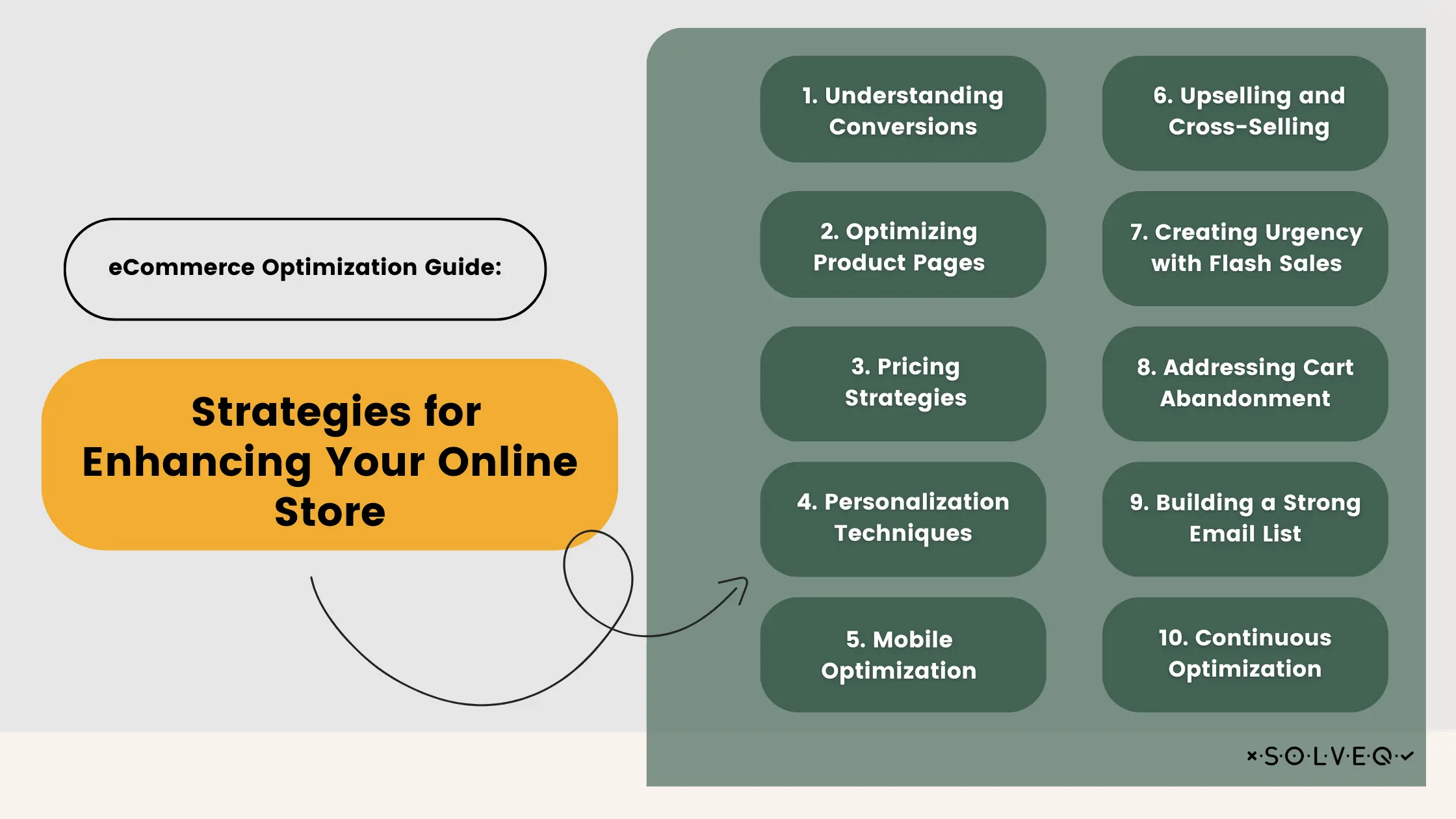eCommerce Optimization Guide: Strategies for Enhancing Your Online Store
7 Mar 2024 • 25 min read

Marcin Kulawik

In the swiftly changing digital marketplace, staying ahead demands a keen focus on ecommerce optimization. This guide offers a comprehensive look at key strategies for enhancing your online store's performance. Drawing insights from industry experts and established practices, it's designed to help you navigate the complexities of ecommerce and stay competitive. From refining user experiences to leveraging the latest marketing techniques, these tactics are tailored for today's online retail landscape.
The need for Ecommerce Optimization
In today's dynamic digital marketplace, ecommerce optimization is more than a luxury; it's a necessity. This practice is centered around understanding and responding to your customers' needs, making it the cornerstone of a thriving online business. Effective optimization ensures your website is not just a collection of products but a responsive, user-friendly platform that resonates with your audience's preferences and behaviors. It involves regular updates and tweaks based on customer feedback and market trends, ensuring your store remains relevant, accessible, and engaging. As we delve into this article, we'll explore practical strategies that target these aspects. From refining the user interface to enhancing product descriptions, each tactic is a step towards building a more customer-centric, profitable online store.

Understanding Ecommerce Conversions
Understanding ecommerce conversions is essential for effectively managing and optimizing an online store. Conversion rates, a key performance metric in ecommerce, represent the percentage of visitors who complete a desired action on your website, like making a purchase. These rates not only reflect the effectiveness of your website but also guide strategic decisions to enhance user experience and increase sales. These rates are influenced by a variety of factors, including:
- Traffic Source: The origin of your website's traffic – be it from social media, search engines, or advertisements – can affect conversion rates. For instance, traffic from loyal customers or social media might have higher conversion rates compared to traffic from cold advertising.
- Product Type and Pricing: The nature of the products you sell and their pricing strategy plays a significant role. Typically, luxury or high-priced items have lower conversion rates due to their higher cost and the longer decision-making process involved, whereas impulse-buy items or lower-priced products may have higher conversion rates.
- User Experience: The ease with which users can navigate your website and find what they're looking for is crucial. A seamless, intuitive, and fast-loading site can greatly enhance the likelihood of conversions.
- Device Type: The type of device used by your visitors also impacts conversion rates. For example, desktop users might have higher conversion rates compared to mobile users, often due to a more comfortable shopping experience on larger screens.
- Regional and Industry Variations: Conversion rates can vary based on geographic location and industry. Different markets and product categories have their unique average conversion rates, influenced by local consumer behaviors and market dynamics.
This overview of ecommerce conversions sets the stage for deeper exploration into strategies and tactics for enhancing your online store's performance. By understanding these key factors, you can begin to tailor your approach and improve the overall effectiveness of your ecommerce site.
Optimizing Product Pages
Another important part that could improve your eCommerce is optimizing product pages. A well-optimized product page not only enhances user experience but also contributes significantly to higher conversion rates. Key steps to optimize product pages include:
- Improved Navigation: Ensure that your website's navigation is intuitive and user-friendly. This includes having a clear menu structure, easy-to-find product categories, and a search function with filters. Efficient navigation helps customers find what they're looking for with minimal effort, enhancing their overall shopping experience.
- SEO-Friendly Product Titles: Craft product titles that are not only descriptive and appealing to customers but also optimized for search engines. Use relevant keywords that potential customers are likely to use in their search queries. This helps in improving the visibility of your products in search engine results, thereby attracting more traffic to your site.
- High-Quality Images and Videos: Visuals play a crucial role in ecommerce. Use high-resolution images and videos to showcase your products effectively. Offering multiple views, zoom features, and even 360-degree videos can provide customers with a detailed view, helping them make informed purchase decisions.
- Compelling Product Descriptions: Write product descriptions that are informative, engaging, and persuasive. Highlight key features, benefits, and any unique selling points of your products. Well-crafted descriptions can sway purchasing decisions and reduce the likelihood of returns by ensuring customers know exactly what they are buying.
- Mobile Responsiveness: With a significant number of users shopping on mobile devices, it's essential that your product pages are optimized for mobile. This includes ensuring that images load quickly, text is readable, and buttons are easy to click on smaller screens.
- User Reviews and Ratings: Include customer reviews and ratings on your product pages. These provide social proof and help build trust with potential customers. Positive reviews can significantly influence buying decisions, as they offer real-life testimony of the product's quality and performance.
- Clear Call-to-Action (CTA): Your product pages should have clear and compelling calls-to-action, such as "Add to Cart" or "Buy Now" buttons. These CTAs should be prominently displayed and encourage customers to take the next step in the purchasing process
- Up-to-Date Inventory Information: Display current inventory levels or availability status to create a sense of urgency and to keep customers informed. This helps in managing customer expectations and reduces frustration caused by ordering products that are out of stock.
Implementing these strategies can significantly enhance the effectiveness of your product pages, leading to better user engagement, higher search engine rankings, and increased conversion rates.

Pricing Strategies
In the world of ecommerce, pricing strategies are much more than just setting a value for your products; they play a crucial role in influencing purchasing decisions. Here's a brief look at effective pricing tactics:
- Comparison Pricing: This tactic involves presenting multiple product options at different price points. By doing this, you can guide customers towards a preferred choice. For example, showing a basic version alongside a premium version can make the latter appear more valuable, encouraging customers to opt for the higher-priced item.
- Charm Pricing: Often, prices ending in ".99" are perceived as significantly lower than they actually are – a concept known as charm pricing. For instance, an item priced at $9.99 is often viewed more favorably than one at $10. It's a subtle psychological trick that can lead to an increase in sales.
- Strategic Use of CTAs: Clear and compelling Call-To-Actions (CTAs) are paramount in ecommerce. They should align with your pricing strategy to nudge customers towards making a purchase. For example, CTAs like "Limited Time Offer" or "Exclusive Discount for First-Time Buyers" can create a sense of urgency or exclusivity, encouraging quicker purchasing decisions.
- Dynamic Pricing: Consider implementing dynamic pricing strategies, where prices are adjusted based on real-time supply, demand, and customer behavior. This approach can maximize profits and competitiveness but requires careful management to avoid customer alienation.
- Bundle Pricing: Offering products in a bundle at a slightly reduced total cost compared to purchasing items individually can be an effective strategy. This not only increases the perceived value but can also encourage customers to buy more than they initially intended.
These strategies, when executed well, can significantly impact your online store's appeal and profitability. The key is to understand your market, your competition, and, most importantly, your customers to tailor your pricing in a way that meets their expectations and maximizes your sales.
Personalization Techniques
Aditionally, personalization in ecommerce is a powerful tool for enhancing customer experience and boosting sales. Effective personalization involves using customer data to tailor the shopping experience to individual preferences and behaviors. Here are some key techniques:
- Tailoring Offers Based on User Data: Use customer data such as past purchases, browsing history, and preferences to personalize the offers they see. For instance, if a customer frequently buys books from a specific genre, showing them new releases in that genre can prompt further purchases.
- Adapting Site Navigation: Personalize the website's navigation for repeat visitors based on their previous interactions. This could mean highlighting categories or products they showed interest in, or even rearranging menu items to match their browsing habits.
- Customizing Marketing Emails: Email marketing can be highly effective when personalized. Segment your email list based on customer behavior and preferences. Send targeted emails that include products or offers relevant to each segment. For example, customers who abandoned their cart could receive an email reminding them of the items with an added incentive to complete the purchase.
- Product Recommendations: Leverage algorithms to recommend products that the customer is likely to be interested in. This can be based on their past purchases, items they've viewed, or what similar customers have bought.
- Personalized Content and Messaging: Tailor the content and messaging on your site to resonate with the user's interests and behaviors. For instance, display a custom welcome message for returning customers or show location-specific information.
By implementing these personalization techniques, ecommerce businesses can create a more engaging and relevant shopping experience for each customer, leading to increased satisfaction and loyalty. Remember, the key to successful personalization is in striking the right balance - it should feel helpful, not intrusive.

Mobile Optimization
As the purchase on mobile devices is the predominant way to make online shopping, optimizing your e-commerce site for mobile users is essential. Here are some strategies to enhance mobile user experience:
- Improve Site Speed: Mobile users expect quick loading times. Optimize your site's speed by compressing images, leveraging browser caching, and minimizing the use of heavy scripts. Tools like Google PageSpeed Insights can help identify areas for improvement.
- Mobile SEO: Ensure your site is mobile-friendly from an SEO perspective. This includes using responsive design, which adapts your site to fit various screen sizes, and optimizing for mobile search queries, which may differ from desktop queries.
- Streamlined Navigation: Simplify your site's navigation for mobile users. This could mean larger buttons, a simplified menu, and ensuring that key information is easily accessible without excessive scrolling.
- Targeted Mobile Marketing Campaigns: Tailor your marketing campaigns for mobile users. This includes creating mobile-friendly email marketing campaigns and using SMS marketing to reach customers directly on their devices.
- Touch-friendly Design: Make sure your website is touch-friendly, with easy-to-tap elements. Avoid small links or buttons that might be hard to click on a smaller screen.
- Test and Iterate: Regularly test your mobile site with real users to find and fix any usability issues. Use their feedback to make continuous improvements.
By focusing on these mobile optimization strategies, you can provide a better shopping experience for mobile users, which can lead to increased customer satisfaction and higher conversion rates.
Upselling and Cross-Selling
Upselling and cross-selling are powerful tactics in ecommerce to increase average order value and enhance the customer shopping experience. Here's how you can effectively implement these strategies:
- Understanding the Difference: Upselling involves encouraging customers to purchase a more expensive, premium version of a product they are interested in, while cross-selling involves suggesting related or complementary products.
- Personalized Recommendations: Utilize customer data to make personalized upsell and cross-sell suggestions. If a customer is looking at a camera, for example, upsell by suggesting a higher-end model, and cross-sell by recommending accessories like lenses or camera bags.
- Timing and Context: Timing is crucial in both upselling and cross-selling. Make your suggestions when the customer is already engaged, such as during the product selection or at checkout.
- Creating Value Propositions: Focus on how the upsell or cross-sell adds value to the customer's purchase. Highlight benefits like enhanced features, savings through bundling, or the convenience of having an accessory that complements their purchase.
- Training and Customer Support: Train your customer support team to recognize upselling and cross-selling opportunities, ensuring they can provide relevant suggestions and answer questions that might arise.
- Use of Technology: Implement tools and algorithms that can automatically suggest upsells and cross-sells based on customer behavior, browsing history, and purchase patterns.
- A/B Testing: Regularly test and refine your upselling and cross-selling strategies to understand what works best for your customers and your store.
By effectively utilizing upselling and cross-selling strategies, you not only boost your revenue but also improve the shopping experience by helping customers find products that truly meet their needs and enhance their purchase.

Creating Urgency with Flash Sales
There is nothing like good old sale and flash sales and limited-time offers inparticluar are effective strategies for creating a sense of urgency among customers, driving sales and increasing engagement. Here are some tips on utilizing these techniques effectively:
- Clear Time Limits: Make sure your flash sales have a clear start and end time. This creates a sense of urgency and encourages customers to make purchases before the deal expires.
- Promote Heavily: Utilize all your marketing channels - emails, social media, website banners, etc., to promote the flash sale. The key is to ensure that your customers are well aware of the limited-time opportunity.
- Exclusive Offers: Make the deals feel exclusive. This could mean offering a significant discount, a buy-one-get-one-free deal, or exclusive products that are only available during the sale.
- Countdown Timers: Use countdown timers on your website and in your marketing materials. This visual cue helps reinforce the time-sensitive nature of the sale.
- Limited Stock Indicators: Show inventory levels to emphasize the scarcity of the offer. Phrases like "Only 5 left in stock" can prompt customers to purchase more quickly.
- After-Sale Follow-Up: Post-sale, follow up with customers. This can be a thank-you message, a request for feedback, or suggestions for similar products they might like. This helps in building customer relationships and encouraging future purchases.
By effectively planning and executing flash sales, you can create an exciting shopping experience for your customers, encouraging quick decisions and boosting your sales during the sale period.
Addressing Cart Abandonment
Shopping cart abandonment is a common challenge in ecommerce. Implementing strategies to reduce it can significantly boost sales. Here are some effective approaches:
- Exit-Intent Technology: Use exit-intent pop-ups that trigger when a user is about to leave your site. These can offer incentives like discounts or remind users of the items in their cart, potentially encouraging them to complete their purchase.
- Surprise Cost Reduction: Sometimes, customers abandon carts due to unexpected costs. Offering a surprise discount or free shipping when they show signs of leaving can help convert these abandonments into sales.
- Multiple Payment Options: Provide a variety of payment options to cater to different preferences. This includes credit cards, PayPal, and newer methods like Apple Pay or Google Pay. The easier it is for customers to pay in their preferred method, the less likely they are to abandon their cart.
- Streamlined Checkout Process: Simplify the checkout process as much as possible. Minimize the number of steps, and don’t force customers to create an account to make a purchase.
- Follow-Up Emails: Send follow-up emails to customers who have abandoned their carts. Remind them of what they’ve left behind and perhaps include a special offer to encourage them to complete the purchase.
- Transparent Pricing: Ensure all costs, including shipping and taxes, are transparent from the outset. Unexpected costs at the checkout stage are a leading cause of cart abandonment.
By addressing the common reasons behind shopping cart abandonment, you can effectively reduce its occurrence and improve your store’s conversion rate.

Building a Strong Email List
Creating an effective email marketing strategy is pivotal for ecommerce success. Here are tips for building and leveraging a strong email list:
- Engaging Subject Lines: The subject line is your first impression. Make it catchy and compelling to prompt opens. Use humor, curiosity, personalization, or urgency to catch the reader's attention.
- Personalizing Email Content: Tailor your emails to the recipient. Use customer data to personalize the content based on their past purchases, browsing behavior, or preferences. Personalized emails often see higher engagement and conversion rates.
- Segmentation of the Email List: Divide your email list into segments based on customer behaviors, demographics, or purchase history. This allows you to send more targeted and relevant emails to different groups, increasing the effectiveness of your campaigns.
- Valuable Content: Beyond promotions, include content that adds value to your subscribers. This could be tips related to your products, industry news, or customer stories. It keeps your audience engaged and looking forward to your emails.
- Opt-In Strategies: Use effective opt-in strategies to grow your list, like offering a discount for the first purchase, a freebie, or exclusive access to sales for subscribers. Make the sign-up process easy and accessible from various points on your website.
- Testing and Optimization: Regularly test different elements of your email campaigns, like subject lines, email designs, and call-to-action buttons. Use A/B testing to determine what works best and refine your strategy accordingly.
- Compliance and Unsubscribe Options: Ensure your email marketing practices are compliant with laws like GDPR. Always include a clear unsubscribe option in your emails to maintain trust and transparency with your subscribers.
By focusing on these aspects, you can develop a strong email list and use it to foster lasting relationships with your customers, driving both engagement and sales.
Continuous Optimization
A hard truth is that no solution will bring benefits forever. In the fast-paced and ever-evolving world of e-commerce, continuous optimization is not just beneficial, but necessary. This process involves an ongoing cycle of testing, feedback collection, and adaptation. Here's why it's so important:
- Ever-Changing Consumer Behavior: Consumer preferences and behaviors are constantly shifting. Continuous optimization helps you stay in tune with these changes and adjust your strategies accordingly.
- Technological Advancements: The digital landscape is always evolving with new technologies and tools. Regularly updating and testing your ecommerce site ensures you leverage the latest advancements to enhance user experience and efficiency.
- Competitive Edge: The ecommerce market is highly competitive. Continuous optimization allows you to stay ahead of competitors by constantly improving your offerings and customer experience.
- Feedback-Driven Improvements: Regular feedback collection from customers provides valuable insights into their needs and pain points. This information is crucial for making targeted improvements to your site and offerings.
- Testing and Learning: Ongoing A/B testing, user experience testing, and analytics review provide empirical data to inform your decisions. This helps in understanding what works best for your business and audience.
- Adapting to Market Trends: Markets can change rapidly. Continuous optimization helps you quickly adapt to these changes, be it seasonal trends, economic shifts, or changes in consumer sentiment.
In summary, continuous optimization in ecommerce is about being proactive, responsive, and adaptable. It's a commitment to ongoing improvement, ensuring your online business remains relevant, competitive, and aligned with your customers' expectations and needs.

Summary
Effective ecommerce optimization is a continual, dynamic process crucial for staying competitive in the ever-evolving digital market. By employing a range of strategies - from personalizing user experience and enhancing product pages to innovative pricing tactics and robust mobile optimization - online retailers can significantly boost their user engagement and conversion rates. Addressing key areas like cart abandonment and leveraging tools like email marketing further streamline the customer journey. Continuous testing and adaptation are fundamental, ensuring that the ecommerce platform not only meets but anticipates customer needs, driving both satisfaction and sales. Ultimately, these efforts converge to not just attract visitors but convert them into loyal customers, cementing the foundation for sustained business growth and success.
Ready to elevate your digital presence with cutting-edge, cross-platform solutions? Our expert team specializes in end-to-end software development and body leasing, tailor-made to propel your business forward. Connect with us today to transform your ecommerce journey!
Share:
Looking for expert development team?
Schedule a call with Tech Consultant

Marcin Kulawik
Founder and CEO of SolveQ. Huge fan of building things with purpose, agility, and having fun while changing the World. Loves his family, teammates, and nature.